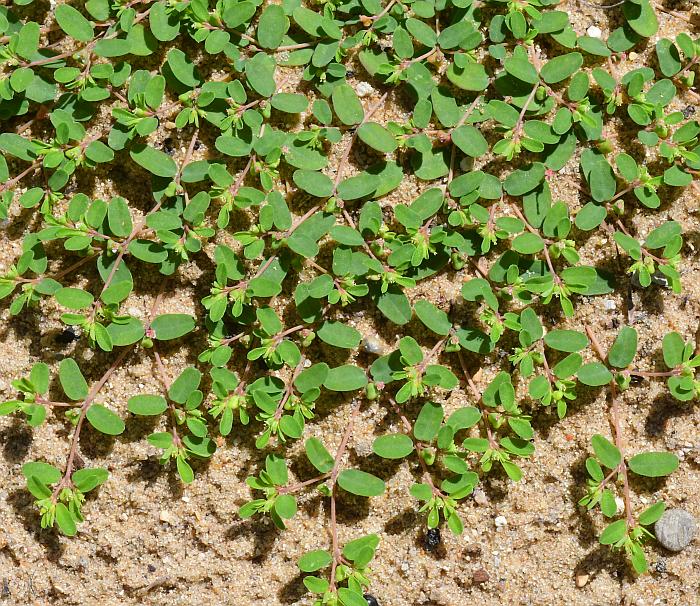Euphorbia geyeri Engelm.
Geyer's Spurge

Native
CC = 10
CW = 5
MOC = 4
SRank = S1
© SRTurner
Euphorbia geyeri Engelm.Geyer's Spurge | |
 |
Native CC = 10 CW = 5 MOC = 4 SRank = S1 |
© SRTurner |
|
Family - Euphorbiaceae Habit - Taprooted annual forb, forming mats. Stem - Prostrate, to 25 cm, branched, loosely mat-forming, tan to yellowish green to pinkish, glabrous. Leaves - Leaves opposite, sessile or nearly so, to 12 mm, oblong, rounded and slightly asymmetric at base, entire, glabrous. Stipules small scales 0.7-1.5 mm long, sometimes fused toward the base, mostly deeply and irregularly fringed or lobed.
Inflorescence - Axillary, solitary cyathia.
Flower - Involucre to 1.5 mm, glabrous. Marginal glands 0.2-0.6 mm, greenish, with inconspicuous petalloid appendage, this white or pinkish. Ovaries glabrous, the styles 0.2-0.5 mm long, each divided 1/3-1/2 of the way from the tip into 2 slender lobes.
Fruits - Capsules 1.5-2.0 mm long, 3-lobed, 3-seeded, glabrous. Seeds 1.3-1.6 mm long, oblong-ovate to ovate in outline, bluntly angular in cross-section, slightly convex at the base, the surface smooth, white to reddish brown, lacking a caruncle.
Flowering - July - October. Habitat - Sand prairies. Origin - Native to the U.S. Lookalikes - Other species of Euphorbia within the Chamaesyce group, most notably E. serpens. Other info. - This small and inconspicuous species is rare in Missouri, and in fact is state listed as S1 (critically imperiled) in the state. Elsewhere its range extends in scattered form across the U.S. Plains region. It is found only in areas of deep sand which support few other species to compete for space and nutrients. The plant is recognized by its prostrate habit, glabrous stems and leaves, and free stipules at each node. The stipules are hairlike and not fused across the node, which differentiates this species from its close lookalike, E. serpens. Its leaves are also slightly larger and more elongated than those of E. serpens. As in other members of the genus, the plant's flowers are minute and clustered into highly modified units called cyathia. Photographs taken near Blodgett, Scott County, MO, 8-28-2015, and near Loda Lake, Newaygo County, MI, 8-29-2020 and 8-11-2022 (SRTurner). |